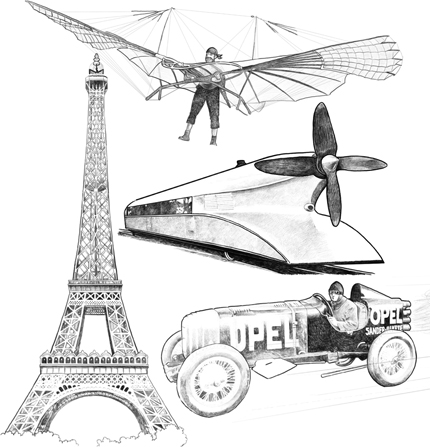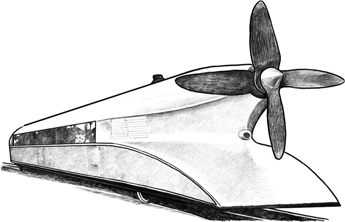DEATH BY INVENTION

Inventors are often willing to do anything to create or improve an invention—they’re even willing to die for the sake of science. These seven unlucky inventors were actually killed while they were working on their creations.
FRANZ REICHELT DEATH BY PARACHUTE
Diving off the Eiffel Tower is never a good idea, even if you have invented a wearable parachute. Franz Reichelt was a tailor who lived in France in 1912. He was fascinated with the new invention of the airplane and was sure his invention of a wearable parachute would save the lives of pilots if their planes were damaged.

He tested his invention by dressing dummies in the parachute suit and throwing them off the Eiffel Tower. The dummies all survived the fall more or less intact. So Reichelt decided to climb up 187 feet and launch himself off the Eiffel Tower. The parachute failed, and Reichelt was killed the instant he hit the ground. The parachute suit was never put into production.
HORACE HUNLEY DEATH BY SUBMARINE

Horace Hunley was a man ahead of his time. During the Civil War, he invented a hand-powered submarine that actually worked. He had visions of his Confederate submarine sneaking up on the Union ships and sinking them. The Union sailors would never imagine the Confederates had built an underwater fighting vessel.
The Confederate Navy was desperate to sink Union ships and began test runs with the submarine. During one test run in August 1863, the submarine got swamped and sank, killing all five crew members.
Hunley and the Confederacy were not willing to give up. They raised the submarine and began new test runs. In October 1863, Hunley went out with the crew and disaster struck again. Horace Hunley and seven other sailors were killed when the submarine went down.
Even after the inventor’s death, the Confederate military was willing to try the submarine again. They raised the submarine, cleaned it up, and in February 1864, they launched the submarine again. This time it successfully attacked and sank the Union ship Housatonic. But the submarine never made it back to shore. All eight of the crew died. In all, there were 21 men killed experimenting with the Hunley submarine. The idea of underwater fighting was not truly successful until the Germans used the U-boat in World War I.
WILLIAM BULLOCK DEATH BY PRINTING PRESS

William Bullock was an inventor during the Industrial Revolution and invented several tools that modernized farming, such as a hay press, seed planter, and grain drill. In 1843, he turned his attention to improving the printing press and invented a web rotary press that allowed for large rolls of paper to continuously feed through the press. This was much faster than hand-feeding individual pages into the press. This revolutionized the speed of printing, increasing the speed to a dizzying 30,000 sheets an hour.
But in 1867, Bullock had a terrible accident while he was making adjustments to one of his presses. His leg was crushed when it got caught in the machine. A few days later, his leg developed gangrene and had to be amputated. Bullock did not survive the operation. He died from the printing press injury on April 12, 1867.
OTTO LILIENTHAL DEATH BY GLIDER

Otto Lilienthal was known as the glider king. As one of the pioneers of aviation, he invented a glider similar to hang gliders that are used today. From 1891 to 1896, Lilienthal made more than 2,000 successful glider flights. But his luck ran out on August 9, 1896: After making a few successful flights that day, his last flight ended in disaster. His glider pitched forward in the wind and plummeted to the Earth. Lilienthal’s mechanic rushed him to the hospital, but there was nothing that could be done. Lilienthal’s last words to his brother were “Sacrifices must be made.” The inventor realized that he was risking his life for the advancement of science and was willing to die in the effort.
ALEXANDER BOGDANOV

Many people have tried to invent a formula for eternal youth. Nobody has ever succeeded, but that fact didn’t stop Alexander Bogdanov from trying. He decided that blood was the key to youth and in 1924, began experimenting with blood transfusions. He began giving himself blood transfusions and claimed that after several transfusions, his eyesight was improved and his balding had stopped. But in 1928, he took the blood of a young man suffering from malaria and tuberculosis. Bogdanov did not understand that disease could be transmitted through blood, and science had not yet learned about different blood types. Instead of eternal youth, Bogdanov died at the age of 55 from his own experiment.
VALERIAN ABAKOVSKY DEATH IN PURSUIT OF SPEED

The Aerowagon was an invention straight out of science fiction. In 1921, young Russian engineer Valerian Abakovsky took a train engine and fitted it with an airplane engine and a propeller. His dream machine could travel at the amazing speed of 140 miles per hour. In 1920, the fastest cars in the world reached top speeds of 99 mph.
The Aerowagon was designed to shuttle Russian officials to and from Moscow, and in July 1921, Abakovsky loaded up a bunch of Russian government officers and took them on a ride from Moscow to Tula. They arrived in Tula in record time, but on the way home, the Aerowagon flew off its rails and crashed. Abakovsky and five of the government officials were killed. The Aerowagon never ran again.
MAX VALIER DEATH IN PURSUIT OF SPACE

In 1924, the idea of space travel seemed crazy to most people. But Max Valier was not most people. He was a trained machinist who had studied physics, and he had written articles on space travel, including “A Daring Trip to Mars.”
He teamed up with Fritz von Opel and began experimenting with rocket-powered cars and aircrafts. He also founded the German spaceflight society, Verein fur Raumschiffahrt. His rocket-powered cars moved at speeds higher than 100 mph and stunned fans throughout Germany. His inventions paved the way for solid rocket fuel engines and modern spaceflight. But in 1930, Valier was experimenting with an alcohol-fueled rocket when it exploded on his test bench. A piece of shrapnel severed his pulmonary artery, and he died within minutes. He was one of the first inventers to die for space experimentation.